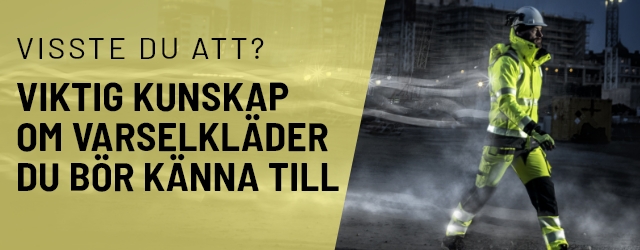-
-
-
-
-
-
-
- Jackets and Vests
- Sweaters
- Shirts
- T-shirt and Pique shirts
- Work trousers
- Shorts and pirate pants
- Hi-Vis Clothing
- Hi-vis rainwear
- Rainwear
- Undergarments
- Underwear and socks
- Skirts and Kilts
- Overalls
- Hats and Caps
- Aprons
- Belts and Braces
- Knee pads and support protection
- Tool Belts and Material Pouches
- Disposable and Chemical Protection
- Protective Clothing, aluminised
- Miscellaneous
- Show fewer
- Show more
-
-
-
-
-
-

Choosing high visibility clothing
Important considerations when choosing high visibility clothing
Are you visible enough in your workplace? There is much to gain by being visible in your workplace, which is a smart way to achieve a safer working environment for both you and others. If you also work outdoors, your workwear requirements are different. Not only do your clothes need to withstand the weather, but you also need to be visible, and this is where high visibility clothing, which is personal protective equipment, comes in. High visibility clothing is used, for example, when working in traffic, road work, rescue work, loading and unloading, where work simply requires high visibility both day and night. Wearing high visibility clothing when working on roads gives drivers a better chance of perceiving a working person on the road and can adjust their speed accordingly.
Consider the following:
- High visibility clothing needs to be washed regularly. Dirty high visibility clothing reduces visibility and high-visibility effects.
- The size of the garment matters. The same garment may have different visibility ratings depending on its size. For example, the total fluorescent area must be at least 0.8 m² to meet class 3. Some small-sized garments may have difficulty reaching class 3, as the fluorescent area is not large enough.
- Reflectors are perishable. Reflectors deteriorate over time and should be replaced regularly.
- An unzipped jacket reduces visibility. Zip up the jacket or wear a high-visibility sweater as a layer 2 for visibility according to classification.
- Pants and jackets should not be hemmed up as this reduces the area of fluorescent material as when the garment was certified. There should be at least 5 cm from the reflector at the bottom of a leg to the edge of the leg.
- Note that sometimes size XS and S have a protection class lower due to the smaller area of fluorescent material. Classification may be affected if you put pressure on your protective clothing. If pressure cannot be applied to the fluorescent fabric, you can always print on the contrasting color.
WASHING TIPS!
High visibility clothing should be washed inside out separately or together with other garments approved according to EN471/EN ISO 20471. Do not use detergent with optical brighteners or softeners or bleaches. Always follow the washing instructions that come with your garment, which include how many times the garment can be washed. Make sure your high visibility clothing is always clean to maintain maximum safety.
How important are good reflectors?
Without reflectors, you are visible only at a distance of 20-30 meters in traffic! With reflectors, the distance increases to 125 meters, which can be crucial in preventing a workplace accident. During the winter months, darkness and poor weather conditions, such as poor visibility due to mist and fog, make it extra important to wear reflectors. Use reflectors and reflective material in many places on the body to increase visibility.
REMEMBER! If you work in traffic, remember that the headlights of cars hit the lower part of the body first, which means that the reflectors on the legs are visible first, so it is extra important that they are intact and clean.
How does a reflector work?
A reflector works when it is dark and there is a light source, such as headlights from a car. The reflector is designed so that most of the light from a light source is reflected back from the reflector to the light source. This means that a driver can see you several seconds earlier than if you did not have a reflector. If the car is traveling at 70 km/h, it can travel nearly 60 meters during these seconds.
What is the difference between the three different protection classes for hi-vis certified garments?
Hi-Vis certified garments are divided into three different classes based on how visible the wearer is. The garments have fluorescent surfaces and reflectors that meet the certification requirements for design, for example, the minimum width of the reflector should be 50 mm. The materials are tested before and after washing, with a minimum of 5 washes, and if the garment has been tested and approved for a higher number of washes, this should be indicated on the washing instructions.
- Class 3 garments are equipped with fluorescent material with a surface area of at least 0.80 m2 and reflectors with a surface area of at least 0.20 m2 for use where the highest level of visibility is required.
- Class 2 garments are equipped with fluorescent material with a surface area of at least 0.50 m2 and reflectors with a surface area of at least 0.13 m2 for use where the visibility requirement is not as high as in class 3.
- Class 1 garments are equipped with fluorescent material with a surface area of at least 0.14 m2 and reflectors with a surface area of at least 0.10 m2 for use where the lowest certified level of visibility is required.
Tip! You can achieve class 3 workwear in different ways. Either by using class 3 workwear or by combining two class 2 workwear, so that together they become class 3 certified.
Common requirements for the three protective classes:
- The garment should be visible both during the day and at night.
- The garment should be visible from all directions.
- Reflectors are placed on the fabric to highlight the person's contours so that the person is not mistaken for, for example, a road sign at road work.
Important! The combination of clothes should be of the same brand and standard to be 100% approved. Warning clothes should be CE-marked and thus comply with the rules on personal protective equipment. The visibility requirements are considered met if the clothes are tested and certified according to the DS/EN ISO 20471 standard.







